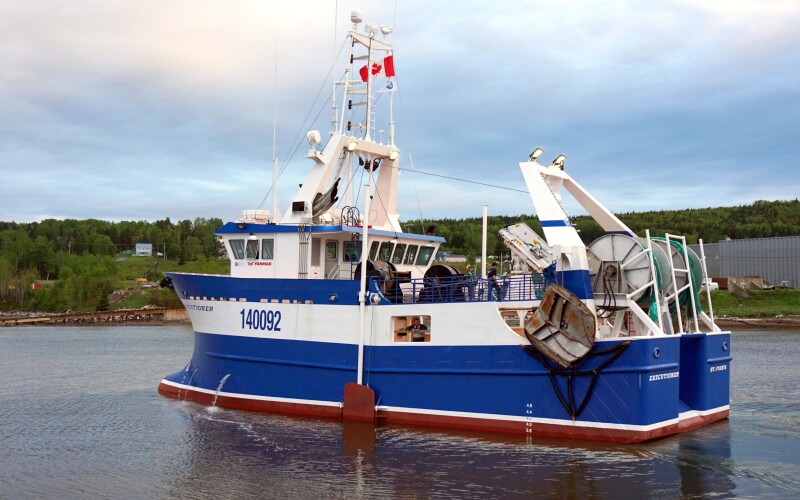Canadian innovator Deepchill is bringing a new kind of ice to the fishing industry.
Kyle Morrison, sales director at Deepchill in Toronto, Ontario, sees structural limitations on how fishermen can protect the quality of their catch.
“The market for number-two salmon is shrinking,” he says. “I understand that Alaska wants to protect the 32-footers (vessels), but there are structural issues in that fishery that make it hard for those boats to compete on quality.”
According to Morrison, refrigerated seawater (RSW) does not keep fish cold enough to maintain them at top quality.
“Up in Bristol Bay those fish come aboard at what, 40 to 50 degrees Fahrenheit. They go into RSW and taken down to 35 degrees, and then they go onto a tender and then to a processing plant. It takes a lot of time, and the core temperature of those fish can be uneven. Some may be at 35, some 38 and others are frozen. The key performance indicator temperature for salmon is 31 degrees.”

According to Morrison, the Deepchill slurry is the right technology to cool fish evenly to that optimum temperature, which he believes is the best way to compete in a market where quality has become vital.
“In almost all ice machines, the ice is created on a surface, and what that does is create flakes that have sharp edges no matter how small you make them.” Deepchill slurry, he explains, is made by freezing seawater in the liquid itself. “With Deepchill we agitate the water so that it can’t freeze on the heat exchanger surface. What this does is allow the ice to form in tiny balls.” The spherical form of the Deepchill slurry gives it some unique properties in the way it moves and the way it cools fish, Morrison points out. “The Deepchill slurry surrounds the fish in the hold, enabling consistent cooling,” he says. “The shape of the crystals does not damage the fish, and our slurry can take the internal temperature of the fish down to 30 degrees without freezing it.”
Although Deepchill has not yet been widely used in Alaska’s salmon fishery, it is being used in aquaculture and aboard a 90-foot Newfoundland trawler, Executioner, owned and operated by Dennis McCarthy. “Dennis typically fishes for crab, groundfish, and shrimp—the latter two have severe shelf life issues,” says Morrison.

Morrison reports that McCarthy sought out a new system after years of experience using flake ice, and that the Deepchill slurry has made a significant difference in the quality of the product McCarthy lands. “McCarthy’s now supplies their processors with fish that are superior in colour and condition, delivered at the ideal temperature — even after being on a longer trip at sea. Products are now sold at a 10-15 percent premium,” a Deepchill case study reports.
“We also have a Deepchill machine on an aquaculture well-boat, and by chilling the fish down to 31 degrees, they extend the shelf life and marketability of their fish,” says Morrison. “What we’re offering to the wild harvesters is a way to get the most from their catch. I’ve heard of processors and tenders losing fish because they couldn’t get them down to temperature, or it took too long.”
The smallest Deepchill slurry maker would take up approximately 52 cubic feet on a Bristol Bay gillnetter, where space is a premium. “That’s not the market we’re looking at,” says Morrison. “The smaller the machine the higher the cost of the slurry, and I don’t know it would work for a gillnetter to spend $85,000 on one of these systems. We’re thinking about the processing plants and the tenders.

If a tender could have a machine and put 1 or 2 cubic meters of Deepchill slurry on a gillnetter, that boat would have about 24 hours to put fish aboard. Then if the tender puts the fish they get into slurry on board, they would be able to deliver a much higher quality product, maybe at a premium.”
The advantage of Deepchill slurry, according to Morrison, is not its temperature. “There’s a misconception that the temperature of ice is what chills the fish,” he says. “But that’s not it. It’s the ice phase changing between solid and liquid that cools the fish, and our slurry goes through that phase change at a higher rate than other slurries.”
Morrison has so much confidence in Deepchill that he is offering to put a system on a tender with a money back guarantee. “I firmly believe that a tender is the best place to put a system. I’d be willing to give a tender a money back guarantee for the first season. If they’re not happy, we’ll come take the system out and give them their money back.”








